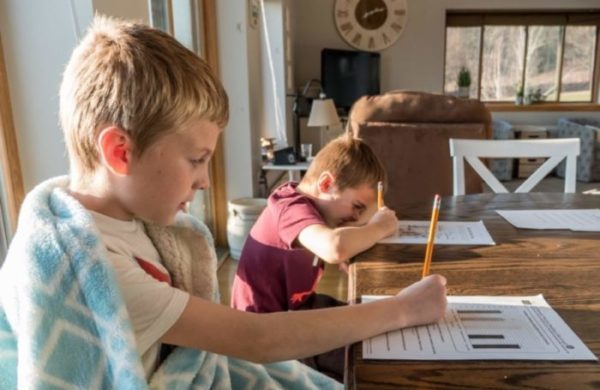Should Children go to School Online this fall?

Concerns About Sending Children Back to the Classroom
One concern with going back to school is that children may be infected but asymptomatic. They would easily spread the virus to others at school, particularly teachers and staff who have a higher risk profile than do the children themselves. The authors of an article published in the journal Pediatrics, on children and COVID-19 transmission, believe that children may be less likely to transmit the virus than are adults. The research is not definitive on this matter, yet it seems hopeful.
Despite the optimistic attitude expressed in Pediatrics, a new study from South Korea reports that only children from birth to 10 years of age are less likely to transmit the virus. Children 10 and older are just as likely to spread the virus as adults. Although the results from this study are not conclusive, there are other studies that seem to support the findings. In response, some states are returning elementary school students to school, but keeping older children in an online setting for the fall.
Another concern with sending children back to the classroom is the recently discovered multisystem inflammatory syndrome. This is a condition in which various body parts become inflamed. The disorder can affect lungs, kidneys, brain, skin, heart or gastrointestinal organs. The CDC is currently investigating multisystem inflammatory syndrome (MIS-C) in children and believe that it is related to COVID-19. The disorder is a very rare, but serious condition that only affects some people, but researchers do not know what causes MIS-C nor do they understand who will be impacted. However, many children with MIS-C either had COVID-19 or had been around someone who was ill with it.
Recent research
In a recently conducted review of state-level data, the American Academy of Pediatrics and the Children’s Hospital Association found that 97,000 children in the United State tested positive for COVID-19 in just the last 2 weeks of July. That’s roughly a 40% increase over the previous total and results in 340,000 children in the U.S. that have tested positive for COVID-19. That is no small number and seems to contradict statements by the administration and other research finding that children are less susceptible to the virus. Although findings generally support the belief that children mostly don’t get very ill, they certainly get the disease and transmit it to others. Also, it looks as if a small percentage of children do get very ill, as discussed in the previous paragraph.
Who is most at risk from returning to the classroom?
Those children with health problems are at greater risk of contracting the virus. Who becomes seriously ill in response to the virus is unclear but researchers believe that, similar to adults, those individuals with preexisting conditions are in the most danger. In the overall population, Black and Latino people have been diagnosed at 3 times the rate of white people. In addition, studies show these groups are twice as likely to die of the disease. Although these results are based on research with adults, there is reason to believe that Black and Latino children have similar rates of risk in relation to white children.
In addition, there is significant risk of infection to adults who work at schools. Despite the best intentions, schools that have opened in Georgia and Mississippi are rapidly facing outbreaks very quickly. In fact, many states that are advocating opening schools have very high infection rates in the overall population. It is only logical that if rates are high in the community, children and teachers in those areas are more likely to get the virus as a result of being in the school setting.
Hard Decisions for Parents
Decisions about reopening schools are difficult and complex. There is much to consider. Children are primed for learning and they do so rapidly and with some skill. The clear structure and expectations in a school setting creates a unique environment designed to facilitate that process. This distinctive arrangement targeting education is difficult to recreate at home where children live, eat, play, & sleep.
There are places in Europe and around the world where kids have returned to school already. They regularly test students, find an outbreak, conduct contact tracing, and close classrooms or groups as needed. Children and staff who have not become ill come back to school 2 weeks later. This process repeats itself as new outbreaks arise. Some schools establish small “pods” or groups of children and staff who are isolated in the overall school environment in order to minimize the number of people who must quarantine in response to any given outbreak. That may be as good as it gets during a pandemic.
There are many reasons to want our children in the classroom. For example, special needs children will likely be left behind in an online setting. They require more individualized instruction that is often not available in an online setting. Schools are currently overwhelmed with creating a workable system for the majority of kids. They will focus on specialized groups of children after that, which will occur in an indefinite timeframe. Given the unsatisfactory services available to special needs students, and parents needing to work, perhaps the European model is a system many of us could live with. Yet, the risks are higher than schooling children at home.
What do Scientists recommend about Returning to the Classroom?
Scientists clearly recommend that we all stay home as much as possible until our county has less than 5% new infection growth and/or until there is a vaccine. They advise that each county make decisions based on the infection rate in the area, as well as the availability of testing and contact tracing. Each school must have a clear plan regarding what happens when there is a positive case that includes the possibility of closing the school again. Most counties in the U.S. do not currently meet those criteria.
The safest course of action may be to homeschool at this point. Many schools are setting up online schooling and parents can simply follow their curriculum, which is much easier than creating a new one on their own. Many parents would rather just take the opportunity to try homeschooling while the situation seems right despite the challenges involved.
If you are struggling with the decision of where to school your child(ren) this fall, please sign up for a free consultation with me.
I am a psychologist well-versed in working with children, teens, and families as well as an experienced homeschool mom. I am eager to help parents who want a sounding board for their thoughts or someone to help sort through the information overload during this pandemic.
Please sign up to meet with me using the calendar below. If these times don’t work for you, see other times I am available by emailing me at [email protected]

